Choosing the best roofing solution for commercial buildings can be overwhelming, but built-up roofing offers reliable advantages. Commonly used on flat roofs, built-up roofing delivers exceptional durability and energy efficiency while standing up to heavy foot traffic. For building owners in San Antonio, TX, understanding this option’s benefits and drawbacks is essential for making an informed choice. With Shield Roofing’s 25+ years of experience, certifications from top brands, and services tailored to local needs, your commercial roof is guaranteed to be “Built tough! Built to last!”
What Is Built-Up Roofing?
Built-up roofing (BUR) is a durable commercial roof system that dates back to the 1800s. It features layers of asphalt, bitumen, and reinforcing materials, making it ideal for low-slope and flat roofs. BUR excels in extreme weather, foot traffic, and long-term wear.
Installed BUR systems consist of alternating layers of bitumen and felt, topped with gravel or a reflective finish. This design withstands high winds, UV rays, and heavy rain. BUR remains a reliable and cost-effective choice for industrial and commercial properties, particularly in cities like San Antonio, TX.
Key Components of a Built-Up Roof System
BUR features distinct layers that enhance its performance. The foundation consists of a base sheet, providing stability for subsequent layers. Multiple layers of bitumen—either hot asphalt or cold adhesive—are applied to improve waterproofing and durability.
Reinforcing fabric may be added to increase resistance against punctures and tears, crucial for high-traffic commercial properties. The top layer, often gravel or a reflective coating, protects against UV rays and harsh weather while contributing to energy efficiency. This layered design exemplifies the effectiveness of built-up roofing in industrial applications.
How Built-Up Roofing Is Installed
Proper installation is essential for maximizing built-up roofing performance. First, prepare the roof deck for a smooth surface. A base sheet may be added for stability before applying hot asphalt as the adhesive layer. Next, embed layers of reinforcing felt or fabric—known as plies—into the asphalt to enhance strength and create a watertight seal.
Finally, add a cover board and aggregate surfacing, such as gravel, to improve durability and aesthetics while protecting against fire and UV damage. Working with professional contractors ensures adherence to safety standards and minimizes installation risks.
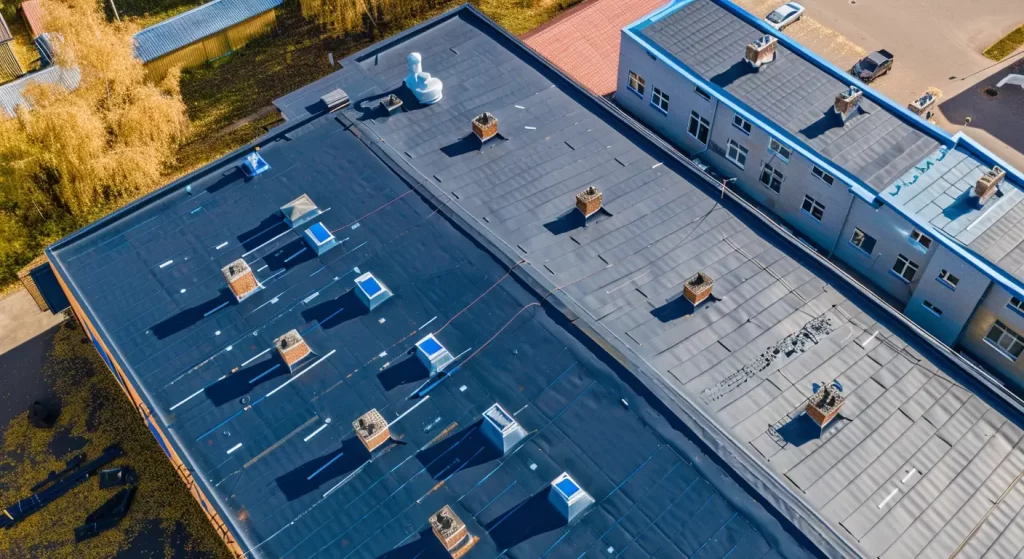
Built-Up Roofing vs. Other Commercial Roofing Types
Choosing the ideal roof system often requires comparing built-up roofing with alternatives. BUR is known for its multi-layered protection, especially for flat roofs that endure extreme weather or heavy traffic.
Other types of commercial roofing, such as single-ply membranes and modified bitumen, offer different benefits like ease of installation and longer lifespans. Building owners must consider factors like energy efficiency, cost, and maintenance when deciding which roofing option suits their property needs for durability and value.
Comparison with Single-Ply Membrane Roofing
A comparison of built-up roofing and single-ply membrane roofing highlights key differences in design, installation, and performance. Built-up roofs feature multiple layers of bitumen and gravel for durability against heavy rain and extreme heat. In contrast, single-ply membranes are lightweight and flexible, making installation and repairs easier.
Single-ply systems, particularly thermoplastic polyolefin, improve energy efficiency and reduce costs for commercial buildings. However, built-up roofs provide better resistance to foot traffic and punctures, making them suitable for high-usage facilities. Ultimately, the choice depends on specific needs and longevity expectations.
Comparison with Modified Bitumen Roofing
Modified bitumen roofing resembles built-up roofing (BUR) in its asphalt composition. Its commercial types include SBS and APP sheets, which are elastomeric for flexibility in varying temperatures. Installation is easier than BUR, using self-adhered or torched cap sheets instead of a multi-layer hot asphalt assembly. While it offers tear resistance, it doesn’t provide BUR’s long-lasting waterproofing.
For durability and low maintenance, BUR is superior; however, modified bitumen is a cost-effective choice for smaller commercial properties and industrial buildings.
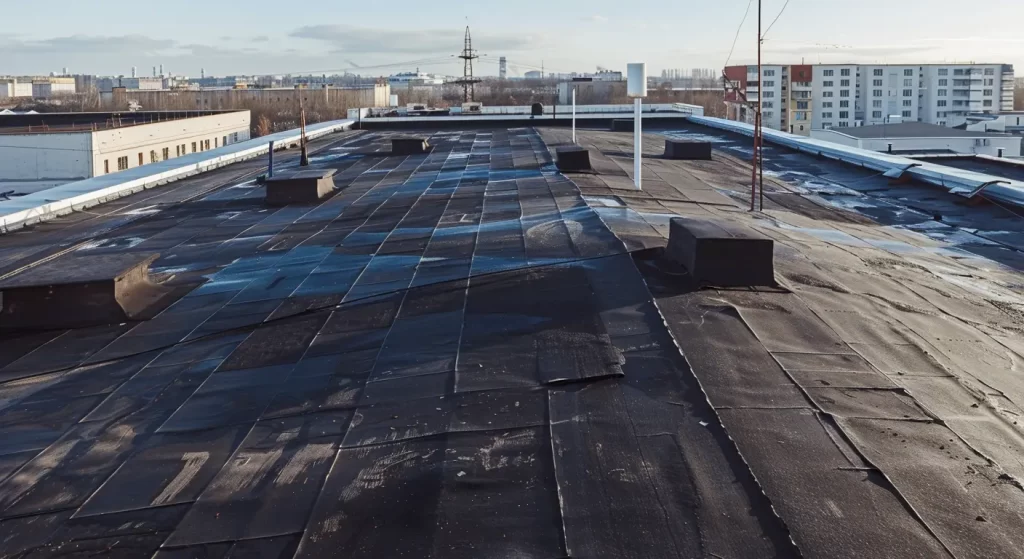
Pros of Built-Up Roofing for Commercial Buildings
BUR provides excellent strength and functionality for commercial buildings. Its ability to resist foot traffic and harsh weather makes it highly reliable.
The pros and cons include durability across many environments and energy efficiency through reflective coatings. These systems have been trusted for decades for their strong foundation and affordability. Building owners prioritizing performance under high use will find BUR a solid commercial roof option with benefits that outweigh some drawbacks.
Durability and Longevity
Built-up roofing systems are known for their durability and longevity, making them a popular choice for commercial property owners. Their multilayered construction, featuring bitumen and materials like gravel or reflective coatings, enhances structural integrity and resistance to harsh weather. This durability enables built-up roofs to endure high winds, extreme heat, and heavy rain, outlasting single-ply or modified bitumen options.
Professional installation boosts resilience, reducing damage and water leak risks. With minimal upkeep required, these roofs offer a low-maintenance solution that lowers long-term energy costs while effectively protecting the building’s interior.
Energy Efficiency and Insulation Benefits
Energy efficiency is a core advantage of BUR roofing for flat roofs. Reflective coatings reduce heat absorption, stabilising internal temperatures even in extreme heat.
The layered insulation traps air, cutting back on energy costs as cooling appliances work less intensively. Building owners can rely on BUR systems for reducing electricity bills without compromising roofing strength.
Additionally, these systems lessen HVAC strain, extending appliance life. Commercial buildings in San Antonio’s hot summers stand to save significantly with BUR systems’ insulating properties.
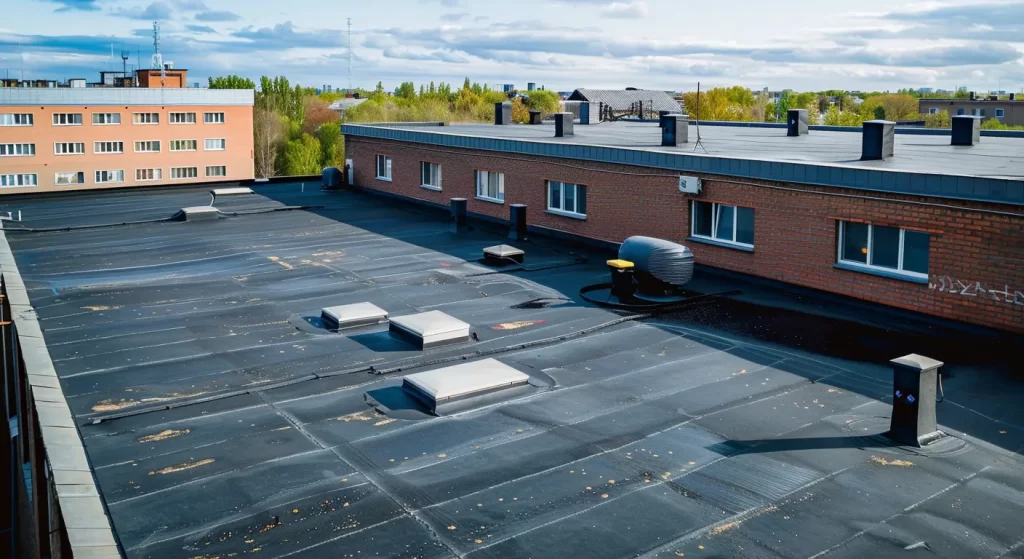
Cons of Built-Up Roofing for Commercial Buildings
Despite its many advantages, built-up roofing has some limitations that potential users should consider carefully. Its installation process can disrupt building operations due to its time-consuming nature, which may lead to inconveniences. It also demands routine maintenance to prevent potential water damage and surface blistering, both of which can be costly if neglected. For property owners seeking minimal upkeep and hassle-free solutions, these drawbacks might outweigh its affordability benefits. Still, hiring experienced contractors can significantly mitigate many of these issues, ensuring reliable performance and longevity of the roofing system.
Installation Time and Disruption
Installing built-up roofing requires detailed execution, often taking longer than modern alternatives. Because the installation process involves heating asphalt, applying multiple layers, and final surfacing, downtime can be significant. For large-scale projects, the timeline expands further, increasing costs per square foot. Businesses undergoing roof replacement may need to vacate premises during the process.
Working with a professional roofing contractor, like Shield Roofing, can improve timelines, guaranteeing a safe and efficient process tailored to San Antonio’s needs.
Maintenance and Repair Considerations
While BUR systems are praised as low maintenance, some care is indeed necessary to maintain roof integrity. Annual roof inspections are critical for spotting issues like open seams, water damage, and blistering. Addressing problems promptly is key to preserving performance and preventing costly roof repairs. Even though routine maintenance is minimal, ensuring equipment stays clear of debris on the roof surface significantly enhances its lifespan. For San Antonio building owners, regular upkeep ensures consistent protection under unpredictable and varying weather conditions.
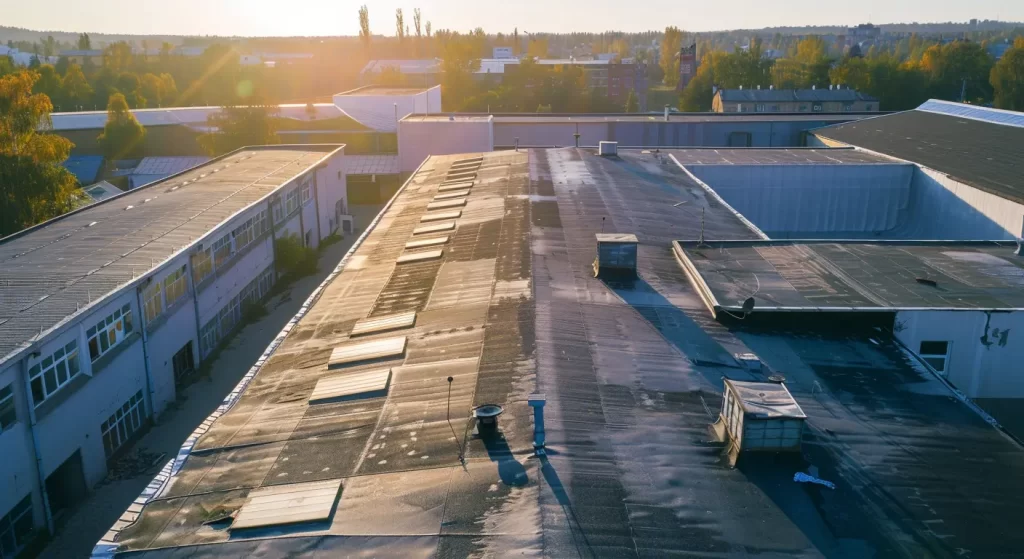
Is Built-Up Roofing Right for San Antonio, TX Businesses?
For commercial properties in San Antonio, built-up roofing offers reliable weather protection and affordability, making it a popular choice among business owners. Its layered construction ensures resilience under Texas heat and heavy rains, providing peace of mind for property managers. However, local weather conditions also significantly influence its overall performance. Businesses prioritising energy efficiency will find BUR systems to be the best option, especially with professional installations that meticulously match local building codes. Shield Roofing’s expertise ensures BUR solutions perfectly align with client needs and San Antonio’s unique demands, ultimately contributing to long-lasting roofing success.
Climate Factors and Weather Resistance
San Antonio’s hot summers and heavy rainfall require roofing materials with excellent weather resistance. Built-up roofing (BUR) is ideal due to its multi-layered design that protects against UV rays and ensures waterproofing during storms. This robust system withstands Texas’s harsh elements, including high winds and extreme heat. Its durability makes BUR a preferred choice for commercial roofs, minimizing weather-related damage and ensuring long-term structural integrity. Investing in a reliable BUR system helps San Antonio property owners protect their assets from severe weather hazards.
Cost Implications for Local Building Owners
Price is an important factor for businesses considering BUR systems. Its cost-effective nature ensures affordability without compromising durability.
Initial roofing services costs are reasonable, especially for local building owners seeking reliable protection. Additionally, BUR’s energy efficiency garners long-term savings on cooling and heating expenses.
Shield Roofing provides knowledgeable consultations, offering good warranties and value-driven installations for San Antonio businesses making roofing investments.
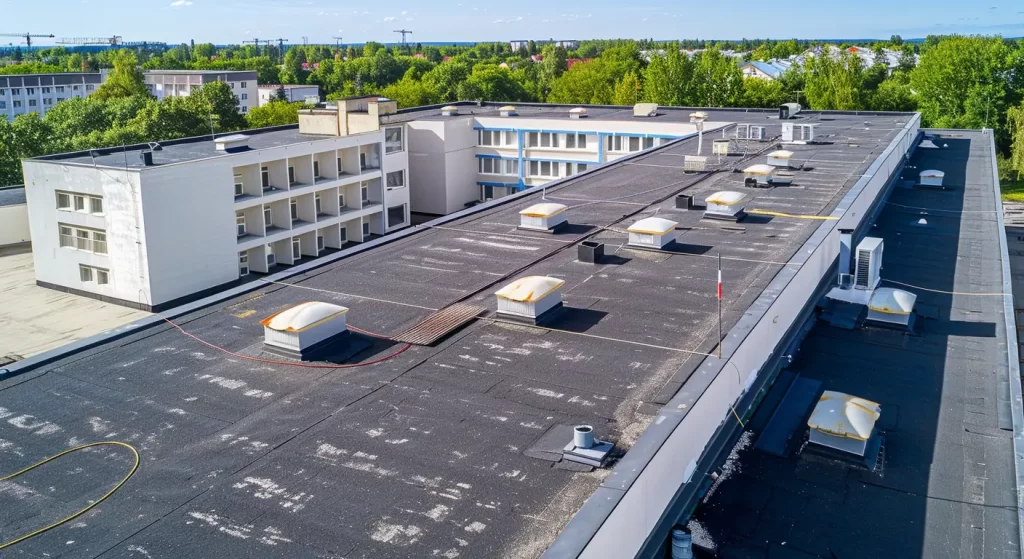
Contact Us
In conclusion, built-up roofing presents both significant benefits and challenges for commercial building owners. Its durability and energy efficiency suit San Antonio’s climate, but longer installation times and maintenance should be considered. At Shield Roofing, we have over 25 years of experience providing quality roofing solutions. As an Owens Corning preferred contractor and GAF certified installer with a BBB A+ rating, we are committed to building tough, lasting roofs. For built-up roofing options or professional advice, contact us today for a consultation!
Read our blog: Negotiating Roof Repairs as Part of a Real Estate Sale
Frequently Asked Questions
Is built-up roofing environmentally friendly?
Built-up roofing contributes to energy efficiency with reflective coatings that significantly reduce heat absorption, leading to lower energy costs. Its multiple layers of asphalt and felt provide moderate eco-friendliness, particularly when installed using sustainable materials, which can further enhance environmental benefits and sustainability practices.
What maintenance does a built-up roof require?
Routine inspections ensure BUR performance. Look for signs of water damage, open seams, or blistering. These checks prevent larger issues from arising, offering relatively minimal upkeep with two annual inspections recommended.
What does pros and cons mean?
“Pros and cons” refer to the benefits and drawbacks of a decision. By evaluating roofing options, commercial buildings can identify the best option aligned with durability, cost, and efficiency for their particular needs.
